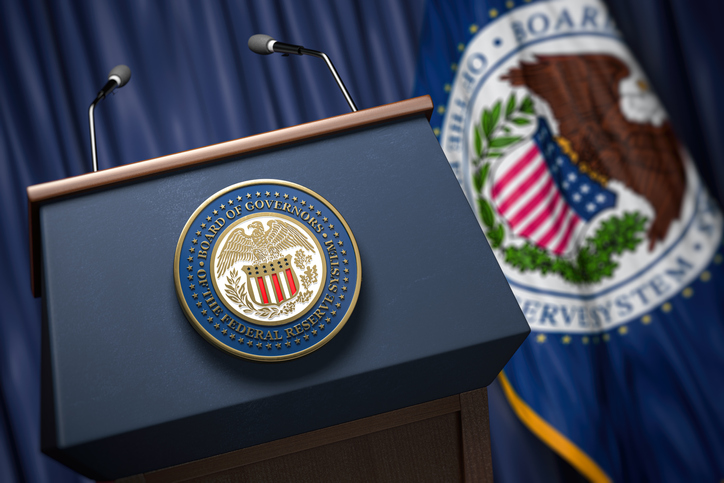
Today, inflation has reached a 40-year high, in response to fiscal profligacy and accommodative monetary policy. Direct cash payments to individuals and businesses in 2020 and 2021, which totaled more than $5 trillion, along with the rapid growth of base money—under the Fed’s large-scale asset purchase program (also known as quantitative easing or QE)—-have combined with global supply-chain disruptions to generate inflation rates that are substantially above the Fed’s long-run goal of 2 percent (Figure 1).
John Cochrane (2022), a Senior Fellow at the Hoover Institution, makes a convincing case that, although inflation generally can be understood as a monetary phenomenon, its roots often can be traced to fiscal dominance—that is, to political pressure to use the central bank to accommodate government deficit spending. Both debt monetization and fiscal helicopter drops—or what Cochrane calls “fiscal inflation”—need to be recognized.
This article examines the fiscal and monetary sources of the current inflation and emphasizes the importance of fiscal rectitude and monetary control in shaping expectations about future inflation. Without sound fiscal and monetary institutions that are transparent, constrained by the rule of law, and trusted by the public, the danger of future inflation will persist.
Fiscal Stimulus and Monetary Accommodation in Response to COVID-19
The U.S. economy came to an abrupt halt in March/April 2020 as the COVID-19 pandemic resulted in the lockdown of normal commercial life. Businesses shut down and millions of workers became unemployed overnight. With unprecedented uncertainty about the future, the demand for cash balances increased and the velocity of money took a sharp downturn, which led to a concomitant decline in nominal GDP. The recession was deep, but short-lived, compared to the Great Recession stemming from the 2008 financial crisis, as Congress and the Fed moved quickly to pump up aggregate demand.
A Fiscal Helicopter Drop
A rush of legislation was passed by Congress and signed into law by President Trump in 2020 to mitigate the ill effects of the pandemic. The “Coronavirus Aid, Relief, and Economic Security Act (CARES Act) was signed on March 27. It appropriated $2.3 trillion for making direct cash payments to individuals, expanding unemployment benefits for workers, and assisting small businesses and industries. On December 27, President Trump signed a second piece of legislation, the “Consolidated Appropriations Act” (CCA), which provided additional relief of $900 billion. In March 2021, when the economy was growing at a healthy pace, Democrats poured fuel on the spending spree by passing the “American Rescue Plan Act of 2021,” which added $1.9 trillion of new spending. Individuals who earned less than $75,000 per year were eligible to receive direct cash payments of $1,400, plus another $1,400 per dependent. (For a summary of these laws, see Alpert 2022.)
John Cochrane likens the more than $5 trillion of COVID-19 relief spending to a fiscal helicopter drop that was sure to generate inflation as the economy quickly recovered from the pandemic. According to Cochrane (2022):
Starting in March 2020, in response to the disruptions of Covid-19, the U.S. government created about $3 trillion of new bank reserves, equivalent to cash, and sent checks to people and businesses. (Mechanically, the Treasury issued $3 trillion of new debt, which the Fed quickly bought in return for $3 trillion of new reserves. The Treasury sent out checks, transferring the reserves to people’s banks.
The Treasury then borrowed another $2 trillion or so and sent more checks. Overall federal debt rose nearly 30 percent. Is it at all a surprise that a year later inflation breaks out? It is hard to ask for a clearer demonstration of fiscal inflation, an immense fiscal helicopter drop.
A key assumption in Cochrane’s analysis is that the debt will never be repaid. Thus, one can treat the debt as a hypothetical bond with a notional, not real, value. Kevin Dowd describes such debt as a “perpetual bond with a zero coupon.” Strictly speaking, the expression “helicopter drop” should only be used when the Fed is literally giving money away to the public (see Friedman).
More importantly, in the post-2008 “floor system,” there is no necessary link between the size of the Fed’s balance sheet and inflation, since reserves can always be sterilized by increasing interest on reserves (more on this later).
Deficits and Money Dance Together
The COVID-19 transfers to households and businesses widened federal deficits, which were financed primarily with accommodative monetary policy. The Fed lowered interest rates, kept them lower for longer, and continued to purchase a large share of Treasuries and mortgage-backed securities. Total assets held by the Fed now stand at about $9 trillion compared to $4 trillion in 2019 (Figure 2). The reserve component of base money more than doubled from March 2020 to August 2021 (Figure 3) as the Fed acquired assets.
The Fed’s decision in 2008 to begin paying interest on reserves—was an alternative to sterilizing its emergency lending during the financial crisis. When the Fed raises the IOR rate above other short-term lending rates, banks have an incentive to lend to the Fed rather than to the market. That policy reduced the multiplier effect of base money (also known as high-powered money) on both M2 (i.e., currency held by the public, demand deposits, certain time deposits, saving accounts, and money market accounts) and NGDP (Figure 4). However, as the economy gained steam in 2021, banks began to increase their private-sector lending, leading to a slight increase in base-money multipliers (see Williams 2012).
Figure 5, based on the work of Fernando Martin at the St. Louis Fed, shows the close relationship between federal deficit spending and M2 in a monetary regime of near-zero interest rates, QE, and forward guidance designed to keep inflation at 2 percent over the long run. As Martin notes, “Both series track each other well, suggesting that the expansion of money in the economy has a fiscal origin.”
During the prepandemic years (2016–2019), M2 grew at an annual rate of 5.6 percent. However, money growth accelerated to 15.6 percent between February and May 2020 once the CARES Act became law in March and the lockdowns took place. A one-time jump in the quantity of money along with a negative supply shock was bound to increase the price level, but long-run inflation requires a sustained increase in M2 (see Thornton 2022). Looking at the data, Martin points out that, following the initial sharp increase, M2 continued to grow at a much faster rate (12.5 percent) than prior to the pandemic. He concludes that, unless money growth slows, inflation can be expected to continue. But, for that to happen, “future deficits need to be persistently large.” From Cochrane’s perspective, it means that the public must expect that the debt will never be repaid. Yet, once again, whether there is future inflation will depend on whether the Fed fails to raise its administered rates soon enough and high enough.
The Failure of the Fed’s New Monetary Framework
In August 2020, the Fed announced several changes to its Statement on Longer-Run Goals and Monetary Policy Strategy. Most importantly, the Federal Open Market Committee (FOMC) adopted “flexible average inflation targeting” (FAIT) that would allow inflation to be “moderately above 2 percent for some time” to make up for past shortfalls. It also redefined its maximum employment mandate as “a broad-based and inclusive goal.” Although that goal is “not directly measurable and changes over time owing largely to nonmonetary factors,” the FOMC‘s “policy decisions must be informed by assessments of the shortfalls of employment from its maximum level” (emphasis added). By substituting “shortfalls” for “deviations,” and by moving to FAIT, the Fed signaled that its employment mandate would take precedence over price stability.
The Fed’s new monetary framework is asymmetrical: it deals only with undershooting the target rate, not with overshooting it. It is also vague: the starting and ending points for FAIT are not specified—that is, there is no clear range over which inflation would be allowed to exceed 2 percent. That uncertainty could lead to selecting a higher average inflation target, which would lead people to expect more inflation in the future.
Earlier, in October 2008, in response to the financial crisis and a near-zero nominal policy rate, the Fed abandoned its traditional “limited-reserves regime” for conducting monetary policy in favor of an “ample-reserves regime.” Instead of using small changes in the supply of reserves to move the fed funds rate in line with the Fed’s target rate, the new framework uses QE to pump up reserves, so that the supply of reserves lands in the flat portion of the demand curve. Meanwhile, the Fed’s target rate is implemented by having the Board of Governors, not the FOMC, administer two rates—the interest on reserve balances (IORB) rate (often shortened to interest on reserves or IOR rate) and the overnight reverse repo (ONRRP) rate. The new operating arrangement means that the Fed’s asset purchases (and thus the size of its balance sheet) can be separated from the stance (i.e., position) of monetary policy (see Plosser 2017; Beckworth 2018; Selgin 2018).
The “divorce” of money (reserves or base money) from the stance of monetary policy (i.e., the Fed’s target range for the federal funds rate) in an ample-reserves regime can be seen in Figure 6. Once reserves are in the flat portion of the demand curve, shifts in the supply of reserves will not affect the fed funds rate, as they did in the pre-2008 framework (see Ihrig and Wolla 2020). Under the new regime, the stance of monetary policy depends primarily on where the Board sets the administered rates it pays on bank reserves and reverse repos.
Todd Keister et al. (2008) nicely summarized the key implication of the ample-reserves regime (also known as the “floor system”) in an article for the New York Fed:
A floor system “divorces” the quantity of money from the interest rate target and, hence, from monetary policy. This divorce gives the central bank two separate policy instruments: the interest rate target can be set according to the usual monetary policy concerns, while the quantity of reserves can be set independently.
What this means is that the Fed can pump up its balance sheet without causing inflation provided it sets its administered rates high enough and soon enough. But there are political limits on how high the IOR rate can go. The public will not look favorably upon large banks receiving high rates on their reserves at the Fed while rates for most people on their bank deposits lag behind. Likewise, Congress won’t like the fact that as the Fed pays higher rates on reserves; remittances to the Treasury will fall. Finally, large increases in the Fed’s balance sheet via asset acquisition—without corresponding increases in the IOR and ONRRP rates—heighten the risk of inflation. The current inflation is testimony to the risk of the Fed waiting too long to raise its administered rates.
Predicting both fiscal deficits and inflation is difficult: forecast errors are common and often large. Top Fed and Treasury officials were caught by surprise with the recent run-up in inflation to a 40-year high. They predicted inflation would be transitory, not that it would now be running at 8.6 percent. They fundamentally ignored the risk of inflation. Indeed, after President Biden signed the $1.9 trillion American Rescue Plan into law on March 11, 2021, Treasury Secretary Janet Yellen, when asked, “Is there a risk of inflation?,” responded: “I think there’s a small risk and I think it’s manageable.” She now admits her forecast error and thinks inflation will “remain high” and should be “our number one priority.”
The failure of the Fed’s post-2008 operating system (see Selgin 2018), and its move to FAIT in 2020, should be addressed if future inflation is to be avoided (see Plosser 2022).
Drawing a Clear Line between Fiscal and Monetary Policy
To stem inflation in the long run, we need moderate levels of monetary growth, for a start, and a clear line of demarcation between fiscal and monetary policy. Since the 2008 financial crisis, the Fed has engaged in credit allocation in close coordination with the Treasury. George Selgin, in his book, The Menace of Fiscal QE (2020), warned against using the Fed’s balance sheet under the floor system to fund projects that may not muster a majority vote. Such “backdoor spending” is facilitated by the Fed’s power to engage in large-scale asset purchases, and the Board of Governors’ authority (since 2008) to pay interest on reserves.
Charles Goodhart, emeritus professor at the London School of Economics, gets to the crux of the problem of fiscal QE in his inside-cover quote for Selgin’s book:
The current “floor system” of money market management in the USA allows the size of the Fed’s balance sheet to be divorced from its mandate to control inflation. This opens the way for some, usually on the political left, to advocate using the Central Bank’s balance sheet to fund all kinds of (idealistic) expenditures, “quasi-fiscal” quantitative easing, thereby avoiding the need for legislative approval and often (mistakenly) perceived as a “free lunch.” George Selgin advocates a return to a “corridor” system of money management to avert such dangers.
Likewise, Cochrane (2022) warns that, “Whether inflation continues or not depends on future monetary policy, future fiscal policy, and whether people change their minds about overall debt repayment.” As he explains:
If the government borrows or prints $5 trillion, with no change in its plan to repay debt, on top of $17 trillion outstanding debt, then the price level will rise a cumulative 30 percent, so that the $22 trillion of debt is worth in real terms what the $17 trillion was before. In essence, absent a credible increase in future surpluses, the deficit is financed by defaulting on $5 trillion of outstanding debt, via inflation.
Cochrane’s message is that, if the root cause of the current inflation is fiscal profligacy, then reforming the fisc is a necessary step toward monetary reform. Government spending needs to slow while economic growth needs to rise; markets, not government bureaucrats, need to set prices; and monetary and fiscal policymakers need to be guided by rules rather than pure discretion.
Conclusion
To say that “inflation is always and everywhere a monetary phenomenon” is not to say that fiscal policy doesn’t matter. “Fiscal inflation” is indeed “a menace,” as Cochrane and others have argued. Few experts predicted the shift from low inflation before the pandemic to nearly 9 percent CPI inflation today. Policymakers largely ignored the implications of the post-2008 operating system, the close dance between cumulative federal deficits and M2 growth, and the risk of adhering to the Fed’s “lower for longer” recipe for its policy rate in the hope of stimulating asset markets and the economy without causing high inflation. The impact of FAIT on inflation expectations was also underestimated. The goal of FAIT was to make up for periods of low inflation with periods of high inflation, but in doing so the FOMC elevated its maximum employment goal and downplayed its price stability mandate. With inflation now at the highest level in 40 years, there could be pressure for increasing the average inflation target to 3 or 4 percent. To do so would be another step away from long-run price stability.
Also, it is important to remember that persistent inflation depends primarily on a continuing excess supply of money, the likely cause of which is fiscal profligacy—and, in the case of the current inflation, large cash transfers directly to individuals and businesses from the U.S. Treasury. Supply-chain effects, to the extent they are a part of the story, should still be effects only on the price level, not the inflation rate. Thus, they should be transitory, not permanent (see Thornton 2022).
Of course, the same is partially true of the fiscal and monetary stimulus. As my colleague Jeff Miron noted (in a recent email):
If we don’t repeat the Covid-19 spending burst, and the spending goes back to its prepandemic level relative to GDP; and/or, if the Fed reverses policy, as it has been doing for past few months, then the fiscal and monetary stimulus should also turn out to have been transitory, and so inflation should subside to a significant degree. But, the key difference is that the debt path has been implying future inflation for years now. The recent fiscal outburst was, at one level, small potatoes relative to the existing path. But maybe it reminded everyone that the fiscal iceberg is out there.
The dangers of fiscal QE, debt monetization, fiscal helicopter drops, and fiscal inflation are real. They need to be taken seriously by policymakers and the public. The FOMC’s 2020 Statement on Longer-Run Goals and Monetary Policy Strategy calls on the Fed “to undertake roughly every five years a thorough public review of its monetary policy strategy, tools, and communication practices.” The FOMC also “seeks to explain its monetary policy decisions to the public as clearly as possible.” Yet, in its policy statement, the Committee specifically says that its goal of maximum employment “is not directly measurable” and that shortfalls from it are therefore difficult to observe. Likewise, there is no specific information regarding the timeframe for achieving an average inflation rate of 2 percent, and no guarantee that the Fed can hit that target. Nor is there any evaluation of how well the floor system has worked or what alternatives would better promote the Fed’s dual mandate as well as provide for moderate long-run interest rates.
If the Fed really wants to be transparent and keep the public informed about the nature of monetary policy, a broader discussion needs to take place, preferably to include alternatives to the present discretionary government fiat money system—and sooner than 2025.
The post The Menace of Fiscal Inflation appeared first on Alt-M.






